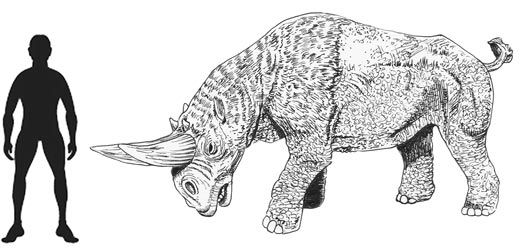Arsinoitherium Distantly Related to Elephants and Sea Cows
Arsinoitherium is one of the most strangest mammals known to science. Although extensive fossil material has been found, largely from the fossil-rich Fayum Beds of Egypt, scientists remained uncertain for decades as to where this large animal should be placed on the placental mammal family tree. Some eighty years or so, since Arsinoitherium was officially described, an analysis of the skull, inner ear and brain casts led scientists to conclude that this heavy-set, herbivore was distantly related to proboscideans (elephants et al) and sirenians (sea cows such as manatees and dugongs). Together with the Proboscidea, Sirenia, the Order to which Arsinoitheres have been classified – the Order Embrithopoda and one other extinct group, the Desmostylia, these are all combined into the clade Tethytheria.
Commenting About Arsinoitherium
The name Tethytheria is derived from the thinking that all these types of mammals evolved in and around the shores of an ancient sea called the Tethys.
A Scale Drawing of the Bizarre Arsinoitherium

Picture credit: Everything Dinosaur
For a model of Arsinoitherium and other prehistoric mammals: CollectA Deluxe Prehistoric Animal Models.
Our Favourite Comments About Arsinoitherium
This strange mammal has been the subject of several fact sheets and drawings sent in to Everything Dinosaur by fans of prehistoric animals. Some of our favourite assertions include:
- Arsinoitherium had a very distinctive skull. It had two, large conical horns that pointed forward and were so big they might have obscured the animal’s vision. The horns were hollow and may have been used as resonating chambers to produce loud calls.
- Arsinoitherium was a very picky eater. It liked to eat leaves and fruit and its size meant that it had to eat all the time.
- Arsinoitherium lived in small family groups and probably spent a lot of time in water. It could not straighten its legs, so it was happy to spend its time swimming and wading in water. The water also helped to keep Arsinoitherium cool.
We are grateful for all the data sheets, drawings and fact sheets on prehistoric animals that have been compiled by young fans of prehistoric animals. We are happy to encourage the creation of what teachers call non-chronological reports, although far be it from us to comment on the assertions relating to Arsinoitheres that have been sent in to us.
Visit the Everything Dinosaur website: Everything Dinosaur.






Leave A Comment